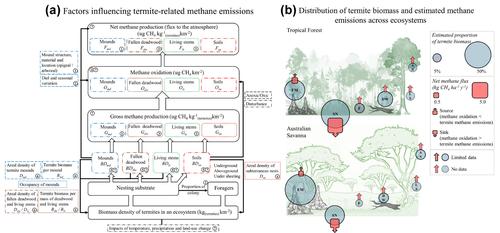当前位置:
X-MOL 学术
›
Glob. Change Biol.
›
论文详情
Our official English website, www.x-mol.net, welcomes your feedback! (Note: you will need to create a separate account there.)
The challenge of estimating global termite methane emissions
Global Change Biology ( IF 10.8 ) Pub Date : 2024-06-20 , DOI: 10.1111/gcb.17390 Stephanie J. Law 1 , Steven D. Allison 2, 3 , Andrew B. Davies 4 , Habacuc Flores‐Moreno 5 , Baptiste J. Wijas 6 , Abbey R. Yatsko 6 , Yong Zhou 7, 8 , Amy E. Zanne 6, 9 , Paul Eggleton 1
Global Change Biology ( IF 10.8 ) Pub Date : 2024-06-20 , DOI: 10.1111/gcb.17390 Stephanie J. Law 1 , Steven D. Allison 2, 3 , Andrew B. Davies 4 , Habacuc Flores‐Moreno 5 , Baptiste J. Wijas 6 , Abbey R. Yatsko 6 , Yong Zhou 7, 8 , Amy E. Zanne 6, 9 , Paul Eggleton 1
Affiliation

|
Methane is a powerful greenhouse gas, more potent than carbon dioxide, and emitted from a variety of natural sources including wetlands, permafrost, mammalian guts and termites. As increases in global temperatures continue to break records, quantifying the magnitudes of key methane sources has never been more pertinent. Over the last 40 years, the contribution of termites to the global methane budget has been subject to much debate. The most recent estimates of termite emissions range between 9 and 15 Tg CH4 year−1 , approximately 4% of emissions from natural sources (excluding wetlands). However, we argue that the current approach for estimating termite contributions to the global methane budget is flawed. Key parameters, namely termite methane emissions from soil, deadwood, living tree stems, epigeal mounds and arboreal nests, are largely ignored in global estimates. This omission occurs because data are lacking and research objectives, crucially, neglect variation in termite ecology. Furthermore, inconsistencies in data collection methods prohibit the pooling of data required to compute global estimates. Here, we summarise the advances made over the last 40 years and illustrate how different aspects of termite ecology can influence the termite contribution to global methane emissions. Additionally, we highlight technological advances that may help researchers investigate termite methane emissions on a larger scale. Finally, we consider dynamic feedback mechanisms of climate warming and land‐use change on termite methane emissions. We conclude that ultimately the global contribution of termites to atmospheric methane remains unknown and thus present an alternative framework for estimating their emissions. To significantly improve estimates, we outline outstanding questions to guide future research efforts.
中文翻译:

估算全球白蚁甲烷排放量的挑战
甲烷是一种强效温室气体,比二氧化碳更有效,由湿地、永久冻土、哺乳动物肠道和白蚁等多种自然资源排放。随着全球气温上升继续打破记录,量化关键甲烷来源的规模变得前所未有的重要。过去 40 年来,白蚁对全球甲烷预算的贡献一直备受争议。最新估计的白蚁排放量在 9 至 15 Tg CH4-1 之间,约占自然源排放量(不包括湿地)的 4%。然而,我们认为目前估计白蚁对全球甲烷预算贡献的方法是有缺陷的。全球估计中很大程度上忽略了关键参数,即白蚁从土壤、枯木、活树干、表层土丘和树栖巢中排放的甲烷。出现这种遗漏是因为缺乏数据,而且最重要的是,研究目标忽视了白蚁生态的变化。此外,数据收集方法的不一致阻碍了计算全球估计所需的数据的汇集。在这里,我们总结了过去 40 年取得的进展,并说明了白蚁生态学的不同方面如何影响白蚁对全球甲烷排放的贡献。此外,我们强调了可能帮助研究人员更大规模地调查白蚁甲烷排放的技术进步。最后,我们考虑气候变暖和土地利用变化对白蚁甲烷排放的动态反馈机制。我们的结论是,最终白蚁对大气甲烷的全球贡献仍然未知,因此提出了估算其排放量的替代框架。 为了显着改进估计,我们概述了悬而未决的问题来指导未来的研究工作。
更新日期:2024-06-20
中文翻译:

估算全球白蚁甲烷排放量的挑战
甲烷是一种强效温室气体,比二氧化碳更有效,由湿地、永久冻土、哺乳动物肠道和白蚁等多种自然资源排放。随着全球气温上升继续打破记录,量化关键甲烷来源的规模变得前所未有的重要。过去 40 年来,白蚁对全球甲烷预算的贡献一直备受争议。最新估计的白蚁排放量在 9 至 15 Tg CH4-1 之间,约占自然源排放量(不包括湿地)的 4%。然而,我们认为目前估计白蚁对全球甲烷预算贡献的方法是有缺陷的。全球估计中很大程度上忽略了关键参数,即白蚁从土壤、枯木、活树干、表层土丘和树栖巢中排放的甲烷。出现这种遗漏是因为缺乏数据,而且最重要的是,研究目标忽视了白蚁生态的变化。此外,数据收集方法的不一致阻碍了计算全球估计所需的数据的汇集。在这里,我们总结了过去 40 年取得的进展,并说明了白蚁生态学的不同方面如何影响白蚁对全球甲烷排放的贡献。此外,我们强调了可能帮助研究人员更大规模地调查白蚁甲烷排放的技术进步。最后,我们考虑气候变暖和土地利用变化对白蚁甲烷排放的动态反馈机制。我们的结论是,最终白蚁对大气甲烷的全球贡献仍然未知,因此提出了估算其排放量的替代框架。 为了显着改进估计,我们概述了悬而未决的问题来指导未来的研究工作。











































 京公网安备 11010802027423号
京公网安备 11010802027423号